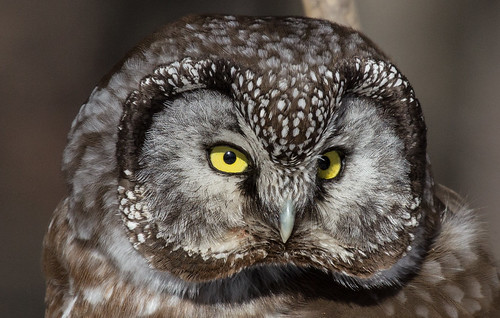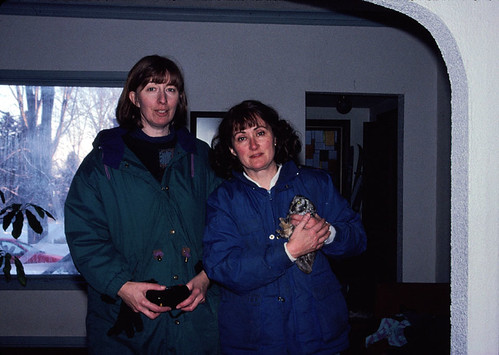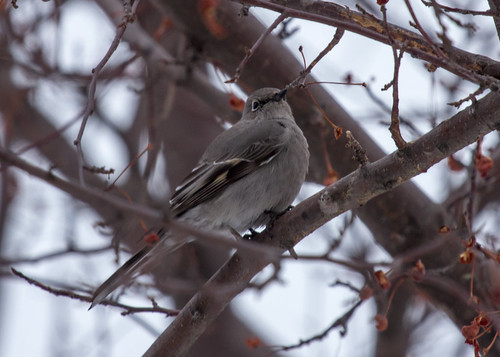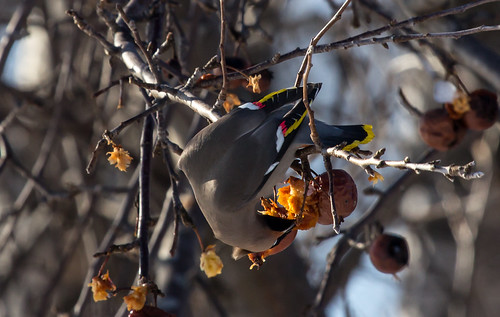
When Russ finished his Ph.D. and was considering job possibilities, I strongly lobbied for the job offer in Duluth, Minnesota. Yes, we were about to start a family and it would be nice to live near where his parents had retired in Port Wing, Wisconsin, and yes, his decision was going to affect his professional standing and career for the rest of his life, but I admit it—my main consideration was the birding. I still needed Great Gray Owl, Northern Hawk Owl, Boreal Owl, and Boreal Chickadee on my lifelist. And to spend each summer day where my most treasured warblers and those dear little Le Conte’s Sparrow actually breed, and to have Evening Grosbeaks as year-round backyard birds—imagine that!
I was expecting my first baby when we moved here in March, 1981, but despite my pregnancy and then our having a newborn, within that same year I’d added two of the owls and the Boreal Chickadee to my lifelist. It took a few years longer to luck into finally seeing a Boreal Owl, but even before that I’d lucked into experiencing their magic. In 1983, a former Duluth doctor named Benton Basham was working on a Big Year and asked Kim Eckert to take him to a Boreal Owl. Kim was one of the world’s authorities on Boreal Owls in Minnesota, having discovered, with Terry Savaloja, the very first Boreal Owl nest ever recorded in the Lower 48, in a nest box in Tofte. Benton was aiming to break the 700-species-in-a-single-year barrier as well as the all-time record for a Big Year (which he did!). To accomplish this, he needed to minimize how many days he spent looking for each exceptional species, so naturally wanted to go out with the best, which is why he asked Kim to take him out for Boreal Owl in April. And Kim generously invited me to come along to the Gunflint Trail with them.
That beautiful evening is still seared into my memory. Northern lights streamed in the sky in the most beautiful display I’d ever seen. In the ethereal brightness, an American Woodcock performed his skydance over and over, far longer into the night than he’d have done if it were darker. After each flight, he alighted on the roadside right in front of us, the first time I’d ever actually watched a woodcock peent. I was thrilled. I don’t remember if Benton had already gotten a woodcock for the year, but whether or not he had, it was an easy species that he could take for granted. Yet he and Kim were also transfixed.
And over and above the woodcock’s peents, from deep within the shadowed forest rang out a Boreal Owl’s sharp calls. Kim and Benton pulled themselves from the woodcock long enough to hike into the dark woods for a glimpse at the owl. Benton already had Boreal Owl on his lifelist so it didn’t matter to his total count if this one was “heard only.” I don’t remember now if he actually saw it or not, but I didn’t want to lower his chances of seeing it—this was, after all, his night and I was just along for fun—so I stayed back on the road, basking in the aurora and the woodcock and the Boreal Owl’s thrilling calls. That was before the American Birding Association allowed people to count heard-only birds on our official lifelists, but the joy of the evening was too intense for me to care about that.
I finally added Boreal Owl to my lifelist on February 1, 1987, when my friend Vada Rudolph discovered one in Saginaw. She was walking her dog when mobbing chickadees alerted her to the little owl’s presence, and it stuck around long enough for many of us to see it. We’ve had a few irruption years since then, when they’ve descended on the Northland in large numbers, so I’ve even been able to see one once in my own backyard.
During the years I was rehabbing, I held many Boreal Owls in my own hands. My best experience was when someone brought me one in March, 1996, the night before the manuscript for my book Sharing the Wonder of Birds with Kids was due at the publisher, when I was also to head out for Nebraska to watch Sandhill Cranes. I was up all night with the little owl on my lap at the computer. First he needed fluids and then I started feeding him strained chicken baby food while I tried to make the final edits to my book, getting up frequently to clean off my goopy keyboard. In the morning, after never getting to bed, I dropped off my manuscript and then headed toward Nebraska, dropping off the owl at the Raptor Center in the Twin Cities en route. Someone from the Raptor Center later told me that of several emaciated Boreal Owls brought to them that year, mine was the only one who survived.

You can tell that I didn’t get any sleep the night before Billie Anderson and I brought this little guy to the Raptor Center!
Anyway, six years after moving here, I’d seen all my target birds, but long after life birds were few and far between, I’ve loved living in this wonderful area characterized by the most haunting species of owls, the most beautiful of breeding warblers, and a host of other birds that make me feel part of one of the loveliest avian communities in the world.
Most years we see at least one or two Snowy Owls, Great Gray Owls, and Northern Hawk Owls. The Duluth area, including the Sax-Zim Bog, harbors northern finches, interesting gulls, and other fun birds as well, so birders from all over the country gravitate to our area just about every winter. And in years when we have an actual irruption of owls, such as the amazing winter of 2004-05 when an astounding number of Great Gray Owls invaded, the numbers of birders who travel here can be truly amazing. This year, even before Boreal Owls showed up, Gustave Axelson (who inherited my former job as science editor at the Cornell Lab of Ornithology) wrote an article for the New York Times about birding in the Sax-Zim Bog, upping the number of visitors from far-flung places dramatically.
If you come to northern Minnesota in hopes of seeing rare birds, you’ll have your best luck if you do your homework first. Here are my tips:
- Kim Eckert’s A Birder’s Guide to Minnesota is essential, both for reading in advance of a trip and having along if you’re coming up here on your own. Kim, the first birder ever to see over 400 species in Minnesota and whose state list still perches above everyone else’s, knows the state as well as anyone. His book includes detailed county maps and Kim’s exceptionally informed descriptions of the best places to go to see each species, along with his tips for finding the birds once you’re there.
- Read postings from the Minnesota Ornithologists’ Union’s MOU-NET listserv to keep abreast of the most recent sightings of “good” birds.
- The Friends of the Sax-Zim Bog has on their website a printable map of the bog with the best feeding stations and hotspots marked. Duluth Audubon Society will soon be updating their map to include all these, too.
- Attend a field trip to the bog (Duluth Audubon Society usually provides a one-day field trip in January or February) or the annual Sax-Zim Bog Birding Festival.
- If your discretionary income allows, consider hiring a guide to take you to the good birds up here. There are several local birding guides. My personal recommendations are limited to guides I know personally and can absolutely attest are extremely professional, have excellent birding skills, are absolutely trustworthy, can deal with complex logistics, safely negotiate tricky roads in wintry conditions, and are warm and pleasant to everyone. I do not list anyone if I’ve ever heard of them using less than ethical means to observe owls, because I care at least as much about these owls’ welfare as I do about people’s (we humans can take care of ourselves better in this altered world than birds can). These are people I can personally vouch for without reservation, in alphabetical order:
Dave Benson. Of the guides I list, Dave is the one with whom I’ve spent the least amount of time. But I know and trust him and his birding skills and fundamental decency. You can contact him by email.
Erik Bruhnke. Erik’s love for birds and for people shines through every experience with him. For several years he’s been one of the naturalists at Hawk Ridge Bird Observatory, has taught ornithology at Northland College, and is an excellent photographer. I have fun and see great birds every single time I go out with him, and then get to enjoy the photos he took of “our” birds. You can see his photography and get contact information from his Naturally Avian website.
Kim Eckert. I met Kim, without realizing it, back in 1978 when both a Barn Owl and Northern Saw-whet Owl turned up on the grounds of the Lincoln Park Zoo in Chicago and Russ and I went there to see them. As we were getting out of the car, he spotted us—he’d been about to leave, but walked all the way through a large section of parking lot to intercept us. He asked if we were there to see the owls, said they were both in different spots than what the hotline reported, and took us to both of them! That’s the kind of guy Kim is, going out of his way to make sure everyone, including perfect strangers, sees good birds. I’ve gone on his Texas and Arizona Minnesota Birding Weeks, and during my 2013 Conservation Big Year, will be going on his Texas and Colorado ones. Kim sets the standard for excellence. His Minnesota Birding Weekends website has a link to his other guiding services.
Frank Nicoletti. Frank was for a long time the counter at Hawk Ridge Bird Observatory, and now directs all the bird banding activities there. He has held in his hands a great many individuals of all our northern owls, and so knows how to get “up close and personal” with them. While he was still spending most of the year in his native New York, he spent one fall living with us while serving as Hawk Ridge counter, so I can attest to his warmth, kindness, and amazing ability to find birds. Follow this link to email Frank.
Sparky Stensaas: Well-known naturalist, author, photographer, videographer, and movie star (ask him!), Sparky is also the force behind the Friends of Sax-Zim. Learn more about all of his projects at his Photo-Naturalist website.



